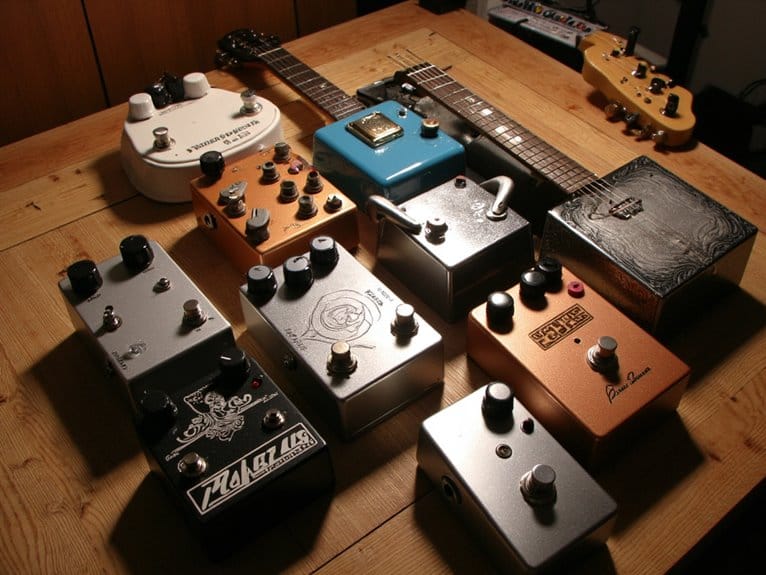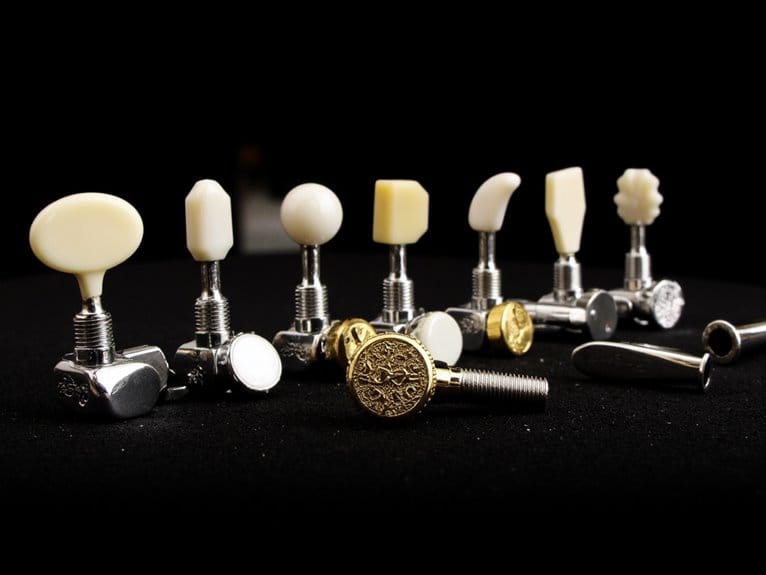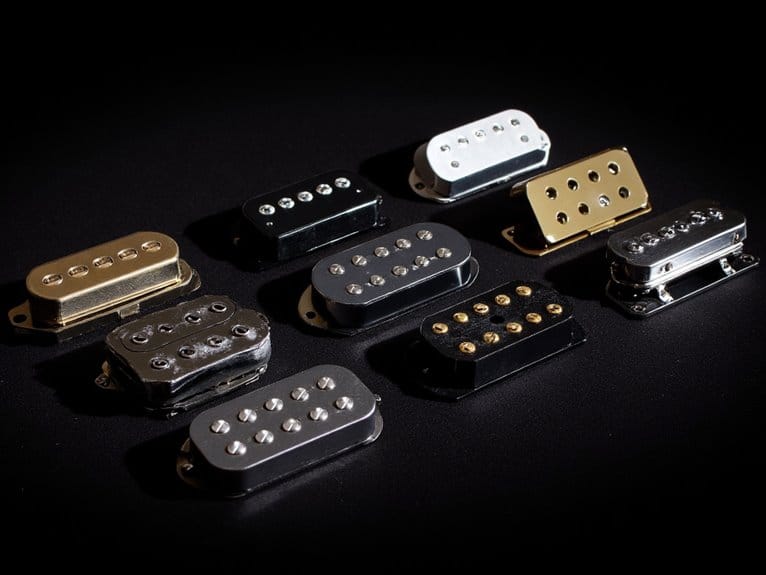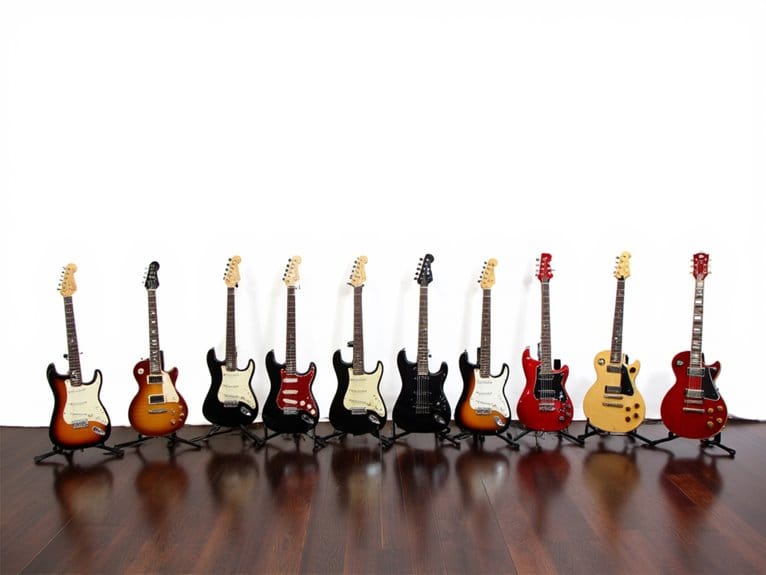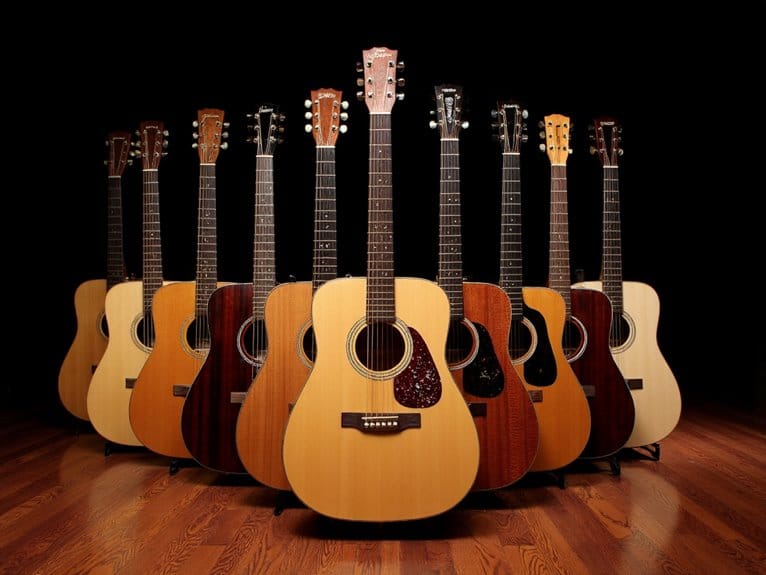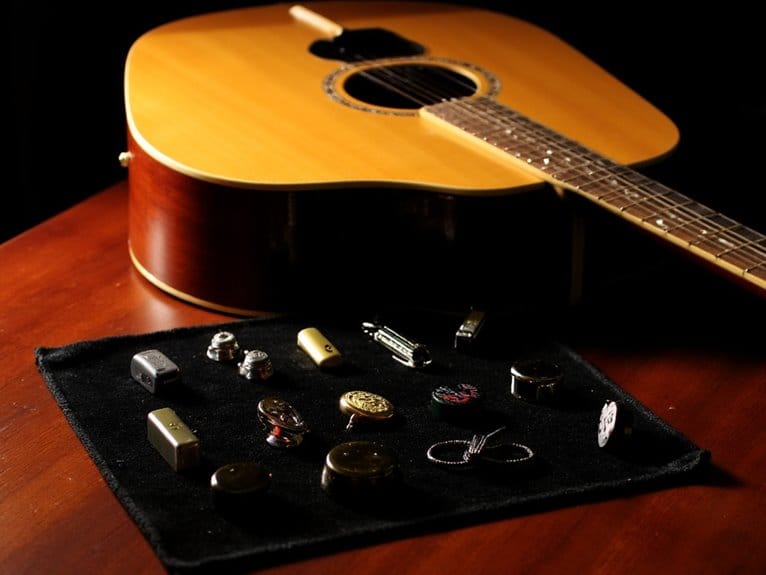Best Boost Guitar Pedals to Amplify Your Sound in 2025
I’ve tested dozens of boost pedals, and the standouts for 2025 include the SONICAKE Clean Boost with its reliable +12dB gain and built-in buffer, the Xotic EP Booster Mini delivering +20dB of Echoplex-inspired warmth, and the versatile AZOR Pure Boost offering 20dB+ gain with two-band EQ. The JHS Prestige excels for simplicity, while the Friedman Buxom provides professional 18V headroom for maximum clean boost potential. Each pedal serves different needs, from transparent signal enhancement to colored tonal shaping, and understanding these distinctions will guide you toward your perfect match.
We are supported by our audience. When you purchase through links on our site, we may earn an affiliate commission, at no extra cost for you. Learn more.
Notable Insights
- Top boost pedals for 2025 include Xotic EP Booster Mini (+20dB), JOYO JF-38 (+35dB), and SONICAKE Clean Boost (+12dB).
- Essential gain ranges span +12dB to +20dB for solos, with some models offering up to +35dB boost capability.
- Choose transparent boosts to preserve natural guitar tone or colored boosts to add warmth and tonal character.
- Key features include true bypass switching, built-in buffers, EQ controls, and durable metal construction for gigging reliability.
- Budget-friendly options like AZOR Pure Boost often outperform expensive models while offering 20dB+ gain and two-band EQ.
SONICAKE Clean Boost Guitar Effects Pedal with +12dB Gain
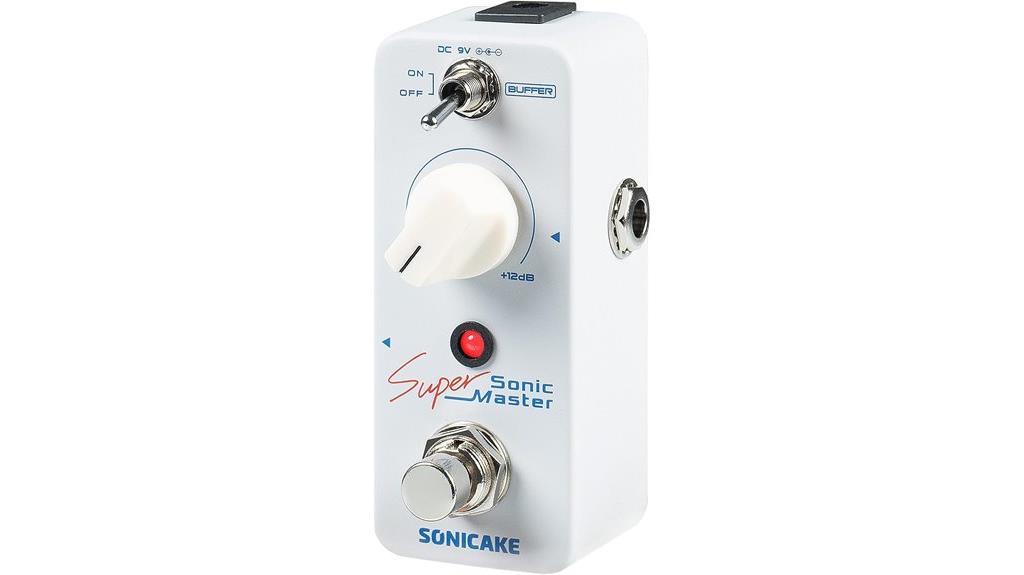
The SONICAKE Clean Boost pedal stands as a demonstration to the principle that effective tone enhancement doesn’t require breaking the bank, delivering a straightforward +12dB gain boost that transforms weak pickups into powerhouse signals without the complexity of multi-function units. You’ll appreciate the built-in buffer function that activates during bypass, maintaining signal integrity across your pedalboard chain without tone degradation that typically plagues long cable runs. The compact 2.44 x 4.13 x 2.44-inch plastic construction proves surprisingly durable, earning “built like a tank” praise from users who’ve tested its resilience. With 4.4 out of 5 stars from over 2,600 customers, this analog pedal delivers exceptional value for musicians seeking clean, transparent gain.
Best For: Musicians seeking an affordable, reliable clean boost pedal that enhances tone and signal strength without unnecessary complexity, particularly those with weak pickups or long cable runs who need transparent gain and signal buffering.
Pros:
- Delivers clean, transparent +12dB gain boost with built-in buffer function that maintains signal integrity during bypass
- Exceptionally durable construction despite plastic body, with users praising its “built like a tank” resilience
- Outstanding value proposition with 4.4/5 stars from over 2,600 customers and compact pedalboard-friendly design
Cons:
- Single button design limits functionality during A/B switching compared to multi-function pedals
- Some users report minimal ground hum issues and noise concerns that may require quality power supplies to resolve
- Power supply not included, requiring separate purchase of 9V center negative power source
Xotic EP Booster Mini EQ Effect Pedal
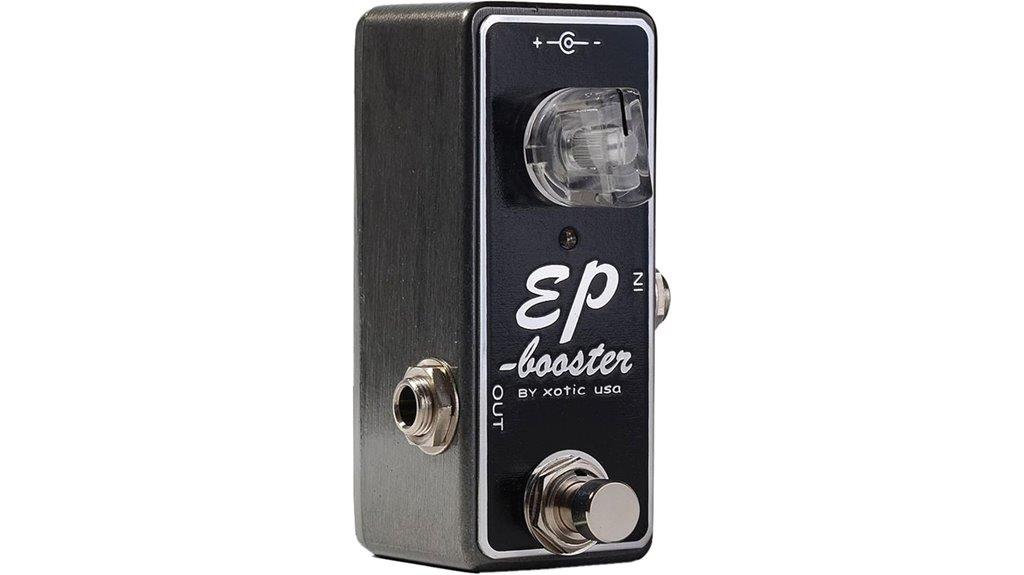
When you’re chasing that elusive, shimmering boost tone that adds sparkle without muddying your signal, Xotic’s EP Booster Mini deserves serious consideration as your go-to clean boost pedal. This discrete FET preamp, based on the classic Echoplex design, delivers up to +20dB of gain while maintaining remarkable tonal integrity across various instruments and amplifiers. The internal DIP switches for bass boost and bright settings provide customization options, though accessing them requires opening the pedal—a minor inconvenience that’s easily forgiven given the pedal’s exceptional performance. With 507 customers rating it 4.6 stars, this compact powerhouse consistently enhances clarity and depth for both studio work and live performances.
Best For: Guitarists seeking a high-quality clean boost pedal that adds clarity and sparkle to their tone without coloring the signal, particularly those using Telecasters, lap steel guitars, or Fender amplifiers.
Pros:
- Delivers up to +20dB of clean gain while maintaining exceptional tonal integrity and clarity
- Internal DIP switches allow customization of bass boost and bright settings for versatile tonal shaping
- Compact design based on classic Echoplex preamp circuitry with excellent build quality and reliability
Cons:
- Internal DIP switches require opening the pedal to access, making real-time adjustments inconvenient
- Limited to boost and EQ functions without overdrive or distortion capabilities
- Relatively high price point compared to basic boost pedals in the market
AZOR Pure Boost Guitar Effect Pedal for Electric Guitar
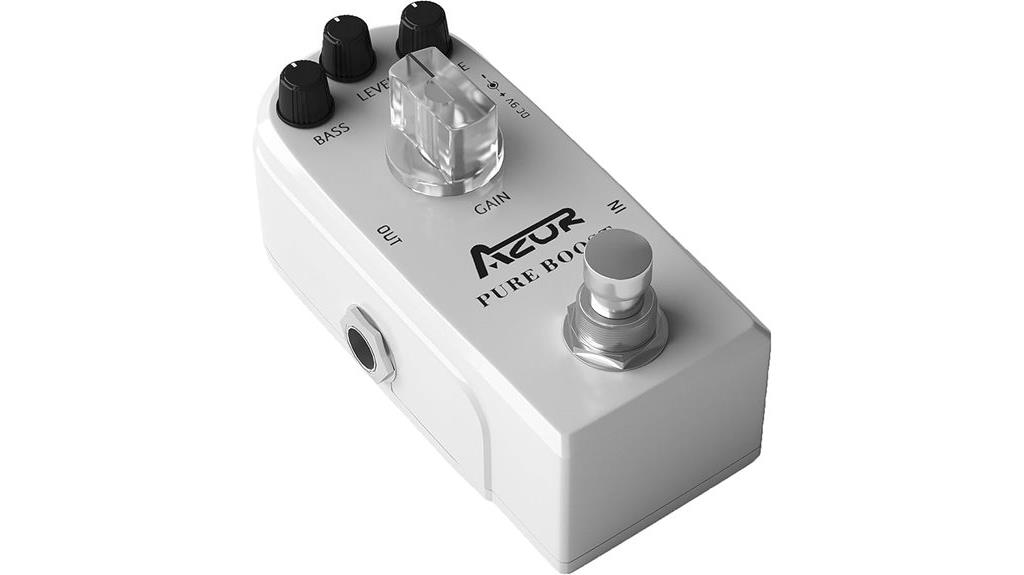
Budget-conscious guitarists seeking professional-grade tone enhancement will find the AZOR Pure Boost Guitar Effect Pedal delivers exceptional value, combining a transparent 20dB+ clean boost with a versatile 15dB two-band EQ in a remarkably compact aluminum chassis that weighs just 7.2 ounces. You’ll appreciate the three intuitive knobs controlling bass, tone, and volume, making sound shaping straightforward without requiring advanced technical knowledge. The true bypass circuitry preserves your signal integrity, while the pedal’s compatibility with overdrive and distortion effects positions it perfectly in your signal chain. With 4.3-star ratings from nearly 4,000 customers, you’re getting reliable performance that works across multiple genres, though some users report minor hissing when engaged.
Best For: Budget-conscious guitarists who want professional-grade tone enhancement with transparent clean boost and versatile EQ capabilities in a compact, reliable pedal that works well across multiple musical genres.
Pros:
- Delivers exceptional value with 20dB+ clean boost and 15dB two-band EQ in a lightweight, compact aluminum chassis
- Features intuitive three-knob design and true bypass circuitry that preserves signal integrity
- Highly rated by nearly 4,000 customers with proven compatibility across overdrive and distortion effects
Cons:
- Some users report minor hissing noise when the pedal is engaged
- Limited control options with only three knobs, lacking advanced features like attack and sustain adjustments
- Inconsistent user experience reported with some models having noise issues
Caline CP-514 Santa Carla Boost Guitar Effect Pedal
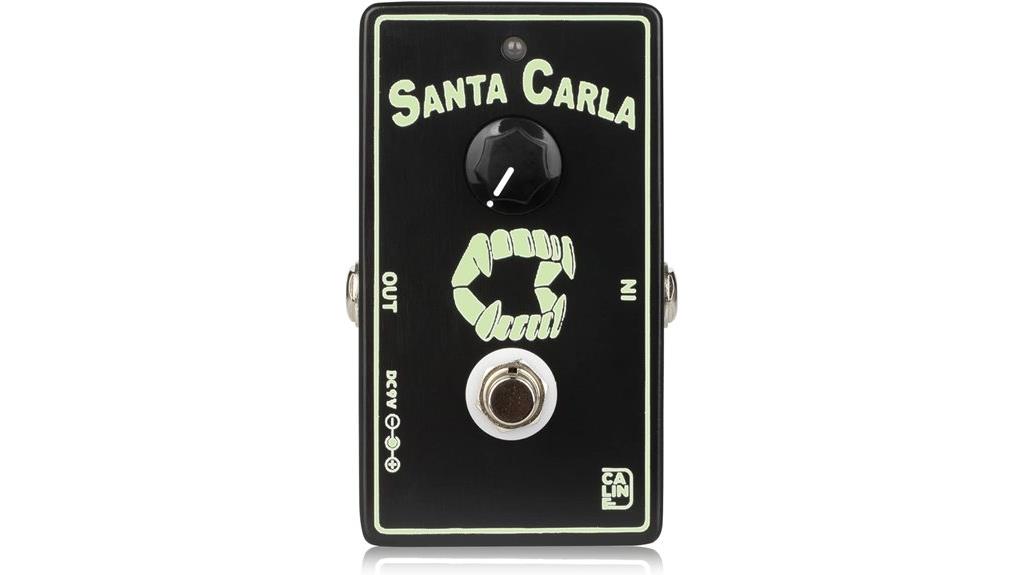
Clean boost enthusiasts seeking versatile gain staging will find the Caline CP-514 Santa Carla particularly compelling, since it offers precise control through six distinct boost levels ranging from +2dB to +20dB. You’ll appreciate the true bypass circuitry that preserves your guitar’s natural signal integrity, while the durable aluminum alloy construction guarantees this pedal withstands regular gigging abuse. The green LED indicator and matching fluorescent silk print create a cohesive aesthetic that’s admittedly more appealing than I initially expected from a budget-oriented manufacturer. This mini booster operates on standard 9V center-negative power, though you’ll need to source your own adapter separately.
Best For: Guitar players who need precise clean boost control for tone shaping and gain staging without altering their instrument’s natural character.
Pros:
- Six distinct boost levels (+2dB to +20dB) provide precise control for various musical situations
- True bypass circuitry maintains signal integrity and preserves your guitar’s natural tone
- Durable aluminum alloy construction can withstand regular gigging and heavy use
Cons:
- 9V power adapter sold separately, adding to the overall cost
- Limited to boost-only functionality without additional tone-shaping features
- Mini pedal size may make it difficult to operate in crowded pedalboard setups
JHS Pedals JHS Prestige Boost Guitar Effects Pedal
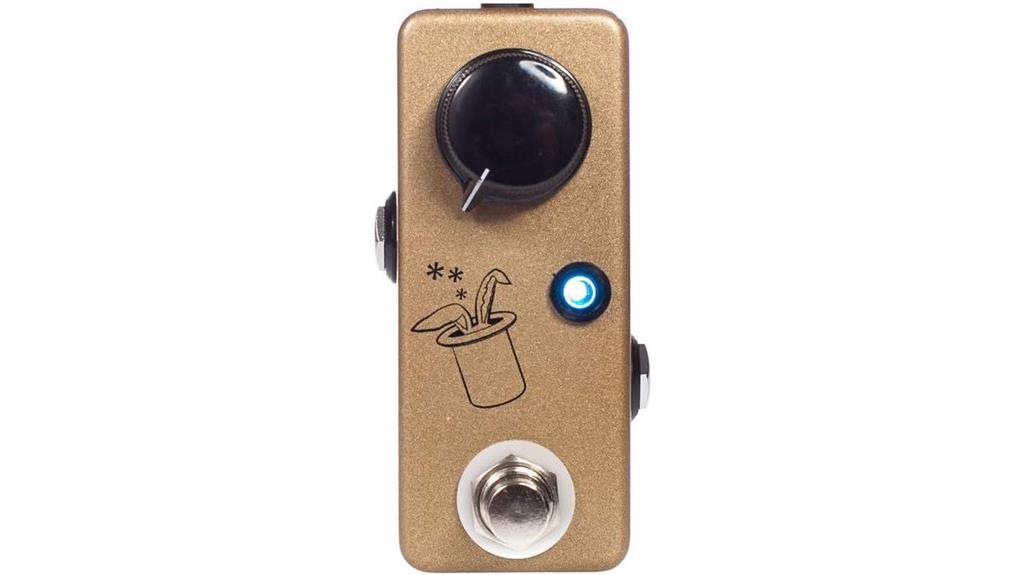
The JHS Pedals Prestige Boost represents simplicity at its finest, offering guitarists who value versatility and clarity a single-knob solution that handles multiple signal enhancement duties without the complexity of multi-parameter controls. You’ll find this pedal excels as a buffer for long cable runs, maintaining signal integrity when you’re running extensive pedalboard setups that typically suffer from tone degradation. The single control operates as an always-on preamp, boosting your signal for solo passages while saturating existing overdrive or pushing your amplifier into natural distortion territory. True-bypass switching guarantees your tone remains uncolored when disengaged, requiring only standard 9V DC power for operation.
Best For: Guitarists who need a simple, versatile boost pedal that can function as a buffer, preamp, and solo boost without the complexity of multiple controls.
Pros:
- Single-knob operation makes it extremely easy to use and adjust quickly during performances
- Multiple functions in one pedal – works as buffer, preamp, and boost for maximum versatility
- True-bypass switching preserves your original tone when the pedal is disengaged
Cons:
- Limited control options may not satisfy players who prefer fine-tuning multiple parameters
- Single knob design means you cannot independently adjust different boost functions
- Requires external 9V power supply which adds to pedalboard power requirements
Pure Boost 20dB+ Clean Boost Pedal for Guitar/Bass
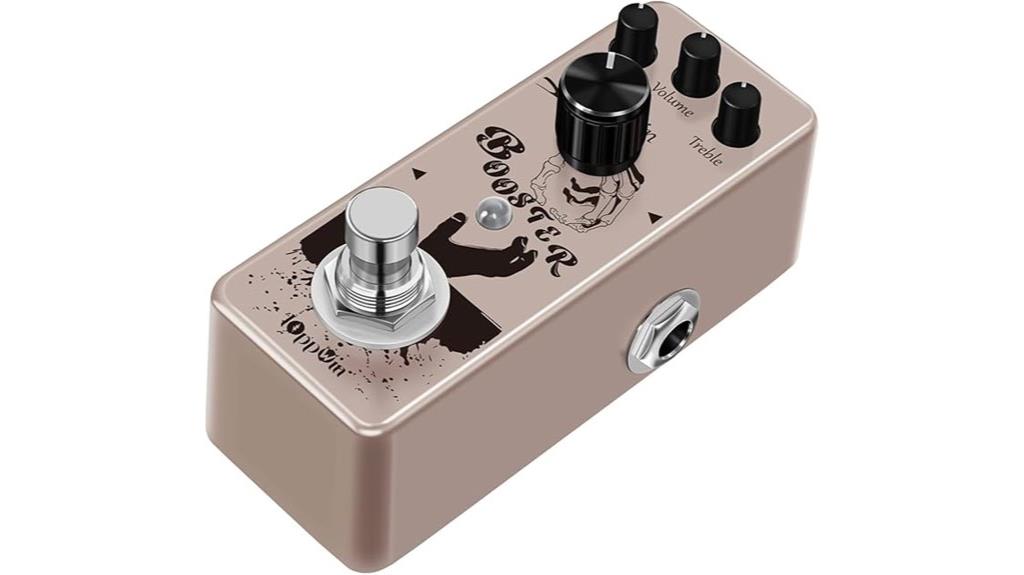
Guitar players seeking a transparent boost that won’t color their carefully crafted tone will find the Pure Boost 20dB+ Clean Boost Pedal delivers exactly what its name promises, offering over 20 decibels of pristine amplification without muddying your signal. The LEF-300’s ±15dB two-band EQ gives you surgical control over highs and lows, while the true bypass switching guarantees zero signal degradation when you’re not boosting. I appreciate how the gain control adds mild overdrive past the 8:00 position, transforming this clean boost into a versatile drive pedal when needed. At 7 ounces with compact dimensions, it’ll fit seamlessly on your pedalboard without hogging precious real estate.
Best For: Guitar and bass players who need a transparent clean boost that preserves their original tone while offering versatile EQ control and the option for mild overdrive when pushed.
Pros:
- Delivers over 20dB of clean boost without coloring your tone, plus ±15dB two-band EQ for precise sound shaping
- True bypass switching ensures zero signal interference when the pedal is inactive
- Compact 7-ounce design with small footprint that won’t take up excessive pedalboard space
Cons:
- Only one customer rating available, making it difficult to assess long-term reliability and performance
- Limited to mild overdrive capabilities when gain is pushed, which may not satisfy players seeking heavier distortion
- Made in China construction may raise quality concerns for some players preferring domestically manufactured pedals
JOYO Boost Pedal Classic Circuitry Electric Guitar Effect (JF-38)
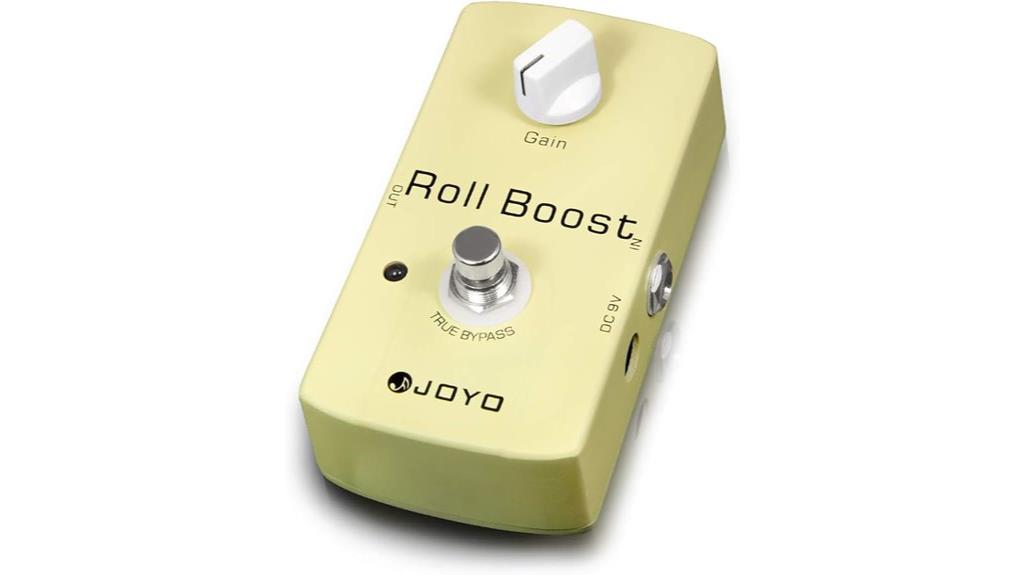
Budget-conscious guitarists who refuse to compromise on tone will find the JOYO JF-38 Roll Boost pedal strikes an impressive balance between affordability and performance, delivering up to 35dB of clean boost that’s powerful enough to push tube amps into natural overdrive or cut through dense mixes during live performances. You’ll appreciate the true bypass design that preserves your guitar’s natural tone when disengaged, while the aluminum-alloy construction guarantees durability that rivals more expensive alternatives. The pedal’s 18V maximum input capability provides exceptional headroom, preventing unwanted distortion even at maximum boost levels, and JOYO’s decade-plus reputation for reliable, budget-friendly effects gives you confidence in your purchase decision.
Best For: Budget-conscious guitarists who need a reliable, high-quality boost pedal to push tube amps into natural overdrive or cut through dense mixes without compromising their guitar’s natural tone.
Pros:
- Delivers up to 35dB of clean boost with true bypass design that preserves natural guitar tone when disengaged
- Durable aluminum-alloy construction with 18V maximum input capability for exceptional headroom and distortion prevention
- Backed by JOYO’s decade-plus reputation for reliable, budget-friendly effects that rival more expensive alternatives
Cons:
- Requires JOYO original power adapter or reliable alternative to avoid unexpected noise issues
- Limited to boost functionality only, lacking additional tonal shaping features found in more versatile pedals
- Single LED indicator may be difficult to see in bright stage lighting conditions
Friedman Amplification Buxom Boost Guitar Effects Pedal

Metal guitarists and high-gain enthusiasts will find their sonic salvation in the Friedman Amplification Buxom Boost, a pedal that transforms tube amplifiers into tighter, more controlled beasts without sacrificing the harmonic richness that makes distortion sing. You’ll appreciate the active 3-band EQ alongside dedicated boost controls, which provide precise tonal sculpting across bass, mid, and treble frequencies while maintaining exceptional clarity. The TIGHT control specifically addresses low-end management when boosting tube amps, preventing unwanted muddiness that typically plagues high-gain setups. Operating at 18V delivers peak performance, maximizing the pedal’s clean boost potential and headroom capabilities that users consistently praise in reviews.
Best For: Metal guitarists and high-gain enthusiasts who need precise tonal control and low-end management to tighten their tube amp sound without losing harmonic richness.
Pros:
- Active 3-band EQ with dedicated boost controls provides exceptional tonal sculpting capabilities across all frequency ranges
- TIGHT control specifically manages tube amp low-end to prevent muddiness when boosting high-gain setups
- Operates at both 9V and 18V with optimal performance at 18V for maximum clean boost potential and headroom
Cons:
- Requires quality power supply and preferably 18V operation to achieve peak performance, adding to setup complexity
- At 8 ounces and 7x4x4 inches, it’s relatively large and heavy for a boost pedal on crowded pedalboards
- Limited appeal beyond metal and high-gain applications due to its specialized design focus
JIM DUNLOP MXR M293 Booster Mini Guitar Effects Pedal, Silver
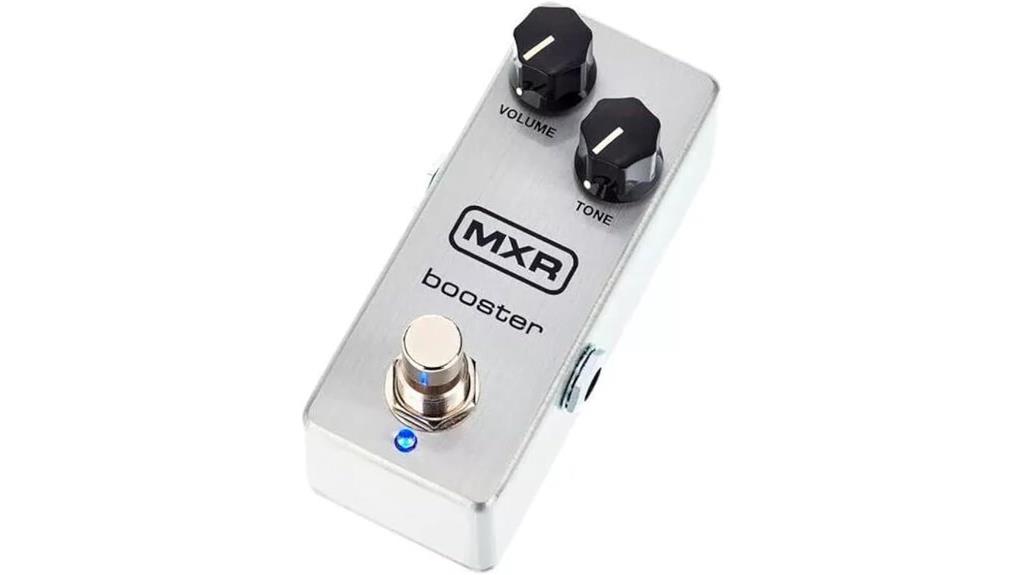
Space-conscious musicians seeking professional-grade tone enhancement will find the JIM DUNLOP MXR M293 Booster Mini Guitar Effects Pedal particularly appealing, as its compact 3.56 x 1.62 x 2.19-inch housing delivers the warmth and character of an internal Echoplex preamp alongside MXR’s proven Micro Amp boost capabilities. You’ll appreciate the +25dB volume control and tone adjustment for high frequencies, though I should mention that accessing the internal trim pot requires unscrewing the back plate, which isn’t exactly convenient mid-gig. While some users report non-transparent coloration at lower settings, this 8-ounce pedal excels at providing everything from subtle enhancement to aggressive drive, earning solid 4.2-star ratings from musicians who value its pedalboard-friendly design and reliable 9-volt operation.
Best For: Space-conscious guitarists who need a compact boost pedal that combines classic Echoplex preamp warmth with flexible volume enhancement capabilities for their pedalboard setup.
Pros:
- Compact, pedalboard-friendly design with powerful +25dB boost capability and built-in Echoplex preamp character
- Versatile performance range from subtle signal enhancement to aggressive drive with tone control for high-frequency adjustment
- Durable construction with reliable 9-volt operation and lightweight 8-ounce design that won’t overcrowd your pedalboard
Cons:
- Internal trim pot adjustment requires unscrewing the back plate, making mid-performance changes impractical
- Non-transparent sound coloration at lower settings may not suit players seeking completely clean boosts
- Mixed user feedback on tone control sensitivity and potential muddiness at certain settings depending on setup
Electro-Harmonix LPB-1 Linear Power Booster Pedal
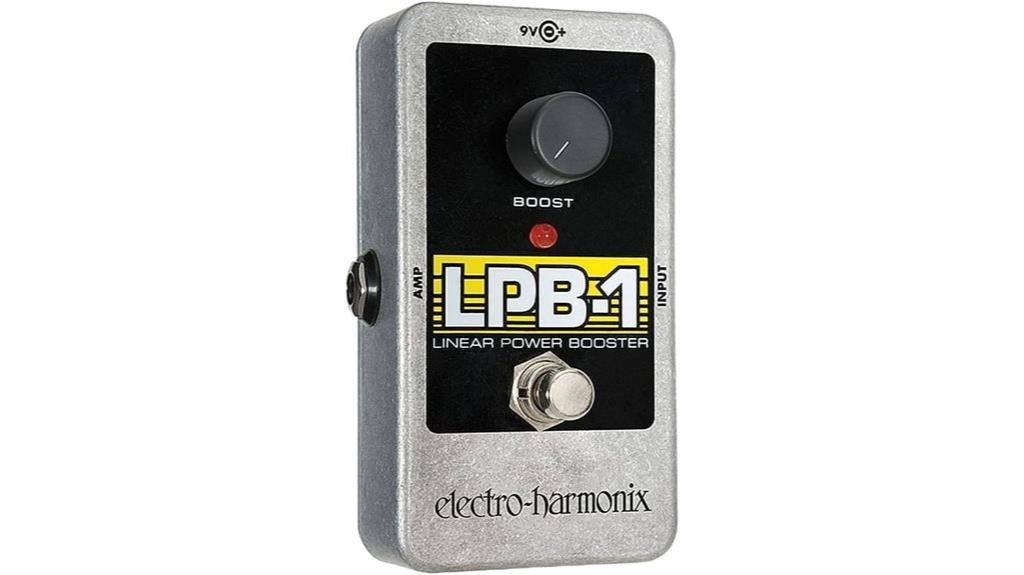
Simple, single-knob operation makes the Electro-Harmonix LPB-1 Linear Power Booster an ideal choice for guitarists who want straightforward gain enhancement without complex controls cluttering their signal chain. This pedal recreates the original 1968 circuit that pioneered overdrive, delivering authentic vintage character through analog signal processing. You’ll notice increased definition and heavier input drive, particularly effective with passive pickups and clean amplifier channels. The unit weighs 10.4 ounces, features 1/4-inch audio interface, and operates on included 9V battery power for reliable performance. At $40, it provides excellent value compared to competitors while enhancing gain and saturation across various amplifier types.
Best For: Guitarists seeking a simple, affordable clean boost or moderate overdrive pedal who want to enhance their amp’s gain and saturation without complex tone controls, particularly blues and rock players using passive pickups with clean or slightly distorted amplifiers.
Pros:
- Exact recreation of the pioneering 1968 overdrive circuit delivers authentic vintage analog tone at an excellent $40 price point
- Simple single-knob operation provides straightforward gain enhancement without cluttering your signal chain with unnecessary controls
- Effective boost in definition and low-end frequencies works well with various amp types, especially beneficial for brightening combo amps
Cons:
- Limited functionality for high-gain setups where amplifiers are already pushed to their headroom limits
- Lacks tone controls for sound shaping, offering only basic gain adjustment compared to more versatile boost pedals
- Noticeable boost in low-end frequencies may not suit all players’ tonal preferences or musical styles
Factors to Consider When Choosing Boost Guitar Pedals
When I’m helping guitarists choose the right boost pedal, I focus on five critical factors that’ll make or break your tone-shaping experience. The gain range determines how much volume and drive you can add to your signal, while the choice between tonal transparency and coloration affects whether the pedal maintains your original sound or adds its own sonic character. I also consider the available EQ controls for frequency shaping, true bypass design for signal integrity, and power supply compatibility to guarantee the pedal integrates seamlessly with your existing pedalboard setup.
Gain Range Requirements
Understanding the gain range you’ll need from a boost pedal requires careful consideration of your playing style, musical genres, and existing amplifier setup, since the wrong choice can either leave you wanting more punch or drowning in unwanted noise. I’ve found that most boost pedals offer gain ranges from +0dB to +35dB, though the sweet spot for solos typically falls between +12dB and +20dB. This range provides noticeable volume increases without excessive distortion, which I appreciate when cutting through dense band mixes. Adjustable gain settings prove invaluable across different genres, allowing subtle boosts for clean passages or aggressive enhancement for heavier sections. Higher gain ranges offer versatility for tone saturation and amplifier driving, but I’ve learned that excessive boosting can introduce unwanted feedback.
Tonal Transparency Vs Coloration
Beyond determining the right gain levels for your needs, the choice between tonal transparency and coloration represents one of the most fundamental decisions you’ll face when selecting a boost pedal, directly impacting how your guitar’s natural voice interacts with your amplifier. I’ve found that transparent pedals excel at preserving your instrument’s inherent characteristics, maintaining flat frequency responses that let your guitar and amp combinations shine through unfiltered. However, colored boosts can add desirable midrange warmth or sonic flavoring that enhances your overall tone palette. Your preference largely depends on whether you want pure volume increases or subtle tonal shaping, though I’ve noticed many pedals offer both options depending on gain settings you choose.
EQ Controls Available
The sophistication of EQ controls can dramatically transform a simple boost pedal from a one-trick volume enhancer into a versatile tone-shaping tool, and I’ve learned that this feature alone often separates budget options from professional-grade units. Basic models offer single-knob gain adjustments with zero tonal flexibility, while premium options like the AZOR Pure Boost provide 15dB controllable EQ for precise live adjustments. I appreciate pedals with internal DIP switches that enable customized Bass Boost and Brightness settings, allowing adaptation to different instruments and playing styles. Active 3-band EQ systems represent the pinnacle of boost pedal versatility, offering independent bass, mid, and treble controls that let you sculpt your tone with surgical precision rather than settling for generic frequency response.
True Bypass Design
Most guitarists don’t realize how profoundly true bypass design affects their signal chain until they’ve experienced the stark difference between a pedal that honors their original tone and one that subtly degrades it, even when supposedly “off.” I’ve found that true bypass circuitry represents one of the most critical yet overlooked features in boost pedals, as it determines whether your guitar’s natural voice remains pristine when you’re not actively using the effect.
True bypass guarantees your signal travels through a simpler circuit path when disengaged, reducing components that can introduce noise or coloration. This maintains your guitar’s clarity, dynamic range, and tonal integrity throughout performances. I particularly value this reliability in live settings, where consistent sound quality matters most, and it enhances pedalboard versatility by allowing seamless integration without compromising your core tone.
Power Supply Compatibility
While exploring power supply options for boost pedals, I’ve discovered that compatibility considerations extend far beyond simply plugging in any 9V adapter you happen to have lying around. Most boost pedals require standard 9V center-negative power supplies, though I’ve found models like the JOYO Boost JF-38 that accept up to 18V for increased headroom and tonal flexibility. Battery-powered options, such as the Electro-Harmonix LPB-1, offer convenient portability with included 9V batteries while maintaining external adapter compatibility for extended studio sessions. I always verify voltage requirements and polarity before connecting any power source, as incorrect specifications can damage circuitry or greatly reduce performance quality, leaving you with disappointing results when you need that perfect signal boost most.
Pedalboard Size Constraints
Beyond ensuring proper power delivery to your boost pedal, physical space becomes the next limiting factor that’ll determine which models actually fit on your existing pedalboard setup. I’ve learned that mini boost pedals vary dramatically in dimensions, ranging from compact 1.3-inch units to larger 4.13-inch models, which greatly impacts your available real estate. If you’re working with tight spacing like I often am, those ultra-compact designs measuring around 1.7 inches wide and 1.3 inches high become invaluable space-savers. Weight considerations matter too, as pedals ranging from 7 to 12 ounces can affect your board’s portability. I always verify that jack layouts and true bypass functionality align with my signal chain requirements while maximizing space efficiency.
Buffer Circuit Benefits
After years of troubleshooting signal degradation issues in my own setups, I’ve discovered that buffer circuits in boost pedals solve one of the most overlooked problems plaguing modern pedalboards: impedance mismatching that slowly degrades your guitar’s natural tone. These active buffer systems maintain consistent tonal characteristics regardless of cable length, preserving high frequencies that typically vanish over long signal paths. Even when your boost pedal’s switched off, the buffer continuously strengthens signal flow to downstream pedals and amplifiers, reducing unwanted noise and hiss that plague weak signals. I’ve found this particularly valuable in complex pedalboard configurations where multiple effects create loading effects, diminishing clarity and definition. True bypass switching guarantees unaltered signal integrity when bypassed, maintaining performance consistency throughout your entire rig.
Price Vs Feature Value
When evaluating boost pedals, I’ve learned that the relationship between price and features isn’t always straightforward, as some budget options surprisingly outperform expensive models in specific applications. I focus on gain range first, since pedals offering +20dB to +35dB provide more versatility than basic +12dB models, though they’ll cost more upfront. Built-in EQ controls and tone shaping capabilities justify higher prices, especially when they eliminate the need for additional pedals in your signal chain.
I’ve found that metal construction typically outlasts plastic alternatives, making the extra investment worthwhile for gigging musicians. Customer reviews consistently reveal that many affordable pedals deliver impressive sound enhancement, while extensive warranties and responsive customer support add significant value that often justifies premium pricing for professional applications.
On a final note
I’ve tested countless boost pedals over the years, and honestly, finding the right one comes down to matching your specific tone goals with your budget. Whether you’re pushing an already overdriven amp into saturation territory, adding sparkle to clean passages, or simply wanting more presence in the mix, these eight pedals offer distinct sonic signatures that’ll elevate your playing. Trust your ears, not the hype.

